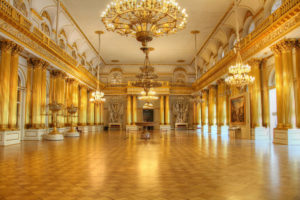
I have just returned from a visit, with good friends and a superb guide, to the fascinating St. Petersburg, a glorious metropolis built in a swamp linked to the Gulf of Finland and famous for its white nights in summer, for it is as far north as Alaska. Founded in 1703 by that colossus of tsars, Peter the Great, as a conduit of Western civilization into a backward Russia, it was the capital until the Soviet era, two hundred years later.
Against fierce resistance from traditionalists, Peter cut the beards of the orthodox priests, allowed women to attend banquets, made marriage voluntary, reformed the army along European lines, founded the Russian navy, and instituted the Academy of Sciences (initially filled by foreigners since no Russians even qualified for university). An example of the task he faced in yanking his people into the modern world is the list of rules he wrote out in his own handwriting for guests at the Peterhof Palace (which he laid out as a Russian equivalent of Versailles). Two of the rules were “Don’t wear your boots to bed†and “Don’t take the silverâ€.
At the time, Russia, which ultimately put a man in space, didn’t even have the wheelbarrow.
The mesmerizing Hermitage is there, pulling together several buildings including the gilt-emblazoned Winter Palace, which was the official residence of the tsars. The museum has three million objects, so many that if you were to spend one minute looking at each, it would take seven years to finish the task.
The Rembrandt room contains twenty-three paintings of the master, including the great exemplar of compassion – The Return of the Prodigal Son. At the time, there was a temporary exhibition of Anselm Kiefer’s works – huge, confrontational paintings dominating two large rooms. And of course, the Impressionists (including the “Absinthe drinkerâ€), some of which were kept hidden for years from the West because they had been stolen from the Nazis who stole them from the original owners and the Russians were afraid they would be claimed.
St. Petersburg blends the beauty of art and architecture with resonances of Russia’s violent history. In the basement of the sumptuous Yusupov Palace, wax effigies of Rasputin and his killer, Felix Yusopov, who lured him there, tell of the extraordinary influence the mesmeric peasant had over the weak and superstitious Royal family. And the Aurora, whose cannon signaled the assault on the Winter Palace that started the Revolution, stands moored in the Neva River.
The stark island Fortress built by Peter at the entrance of the Neva to guard against the Swedes, with whom he was at war for twenty-one years, held Dostoyevsky for a while. Born in St. Petersburg, he had been caught up in the Bolshevik crackdown on dissidents and sentenced to death, even though he was merely associating with some of them. Just as he was about to be executed, his sentence was commuted to ten years imprisonment in Siberia, where he wrote Crime and Punishment, drawing on the characters of fellow prisoners, some of whom were real criminals, others not.
The grim Siege Museum confronts the visitor with the horrors of the Nazi attack in the Great Patriotic War, where eight hundred thousand people died, mostly of starvation, gnawing on leather belts and eating glue in temperatures often forty below zero, Shostakovich wrote his seventh symphony during the siege. It was played on the radio, understandably touching the rawest emotions of all who heard.
Cruising along the Neva, which links with other water- courses in a system of canals that encourages St. Petersburg to be called the Venice of the North, I was impressed by the unity of design of the buildings, each with Baroque style in pale green, a colour concession to the bleak winters. The whole of the Hermitage faces the Neva. And, along the water’s edge, is the apartment where Pushkin died of wounds after a duel with a Frenchman who claimed his wife was unfaithful, a calumny made somewhat credible by the fact that the great author was short and ugly and his wife young and pretty. That, in a racist age, his grandfather was Black didn’t help.
Ornate Baroque churches pop up among the secular buildings, survivors of the Bolshevik attempt to abolish religion. St Isaacs’s cathedral is the most ornate, stunning the eye with gilt, but without stained glass windows, for the technique did not exist in Russia. Religion is now permitted and is on the rise all over the country. Putin supports the Orthodox Church, but not without controversy. Secularists reluctantly do not oppose services but they argue that churches should be treated essentially as museums, with admission charges defraying their maintenance costs, while the priests insist they be entirely places of worship. The rise of religious sensitivity was the background against which Putin’s government, provoked by the behavior of the rock group Pussy Riot, passed a law making it a crime to give offence to believers by insulting the Church
People are a lot more open than they were under the Soviets, when to smile was interpreted as not being serious enough, and even to speak about the government was dangerous. Reports could go to the KGB, whose predecessor was established by Peter the Great as a useful innovation for keeping control. Now people speak freely. We were told that Putin is said to have two faces, one for foreign affairs and one for domestic concerns. They all love the former, as he stands up to the West, but they criticize the latter, as manufacturing has collapsed (but is recovering with the devaluation of the ruble) and unemployment outside the big cities is high. In many cases several families have to share a kitchen. However, with the recovery in the oil price, the economy is picking up somewhat, despite the current sanctions.
Many wealthy people are criticized for corruption, not only the oligarchs. However, nobody cares about Putin having twenty dachas (country houses) because he is the tsar and monarchs have always been rich at the nation’s expense. Undoubtedly Putin is popular, but some say it’s because his youth and fitness are contrasted with Yeltsin, his elderly vodka-sodden predecessor. The constant drum beat of propaganda helps.
Regardless of the straightened economic conditions elsewhere in Russia, St. Petersburg is bustling with wealth, most of it thanks to the seven million tourists who visit each year. The palaces and churches are freshly painted and the ever-present gilt shines bright everywhere. New cars are in the streets and not a scrap of rubbish is there to offend the eye.
And the restaurants serve food that is as tasty as its Soviet predecessor was inedible. My favourite was beef Stroganoff, a dish invented by a wealthy burgher of that name. Known to Catherine the Great, Stroganoff loved to entertain. His palace was constantly jammed with bibulous and hungry guests. One time however, when the generous host saw the number of carriages coming in, he realized he had to do something innovative to cater for the multitude. In a frantic session, he and his chef worked out a solution that would streamline the dinner. Knowing that Russians eat sour cream with almost everything, they created a dish with that, mushrooms and strips of beef, easily prepared. It worked then and works to this day.
The culture of Peter’s city is wide and profound, too much to appreciate in one visit at more than a superficial level. However, its immediate charm makes one want to drink deep, as Alexander Pope advises.
Tony Grey
